Key takeaways from Sinch Mailgun’s Email and the customer experience 2024
A global survey shows many consumers prefer the email channel for customer communication. Discover other important highlights from an exclusive report revealing their habits and preferences so you can build a better customer experience.
PUBLISHED ON
No one denies that email is an important connecting point between businesses and consumers as well as applications and users. Now, a new study shows just how crucial the inbox is to brand communications and the overall customer experience.
As organizations adjust to updated bulk sender requirements from Gmail and Yahoo, it’s more important than ever to ensure you do what you can to keep people engaged.
Late last year, Sinch Mailgun surveyed more than 2,000 consumers in the U.S., UK, France, Germany, and Spain to find out how they prefer to hear from brands. The survey also asked consumers how they interact with their inboxes and what motivates them to engage with email communications.
We’ll explore some of the key findings from the research below. You can also download the full report, “Email and the customer experience”.
Table of contents
The mobile email experience
Email is the top choice for customer communication
Perhaps the clearest finding in this report is that email is the most preferred way to hear from brands. That goes for both promotions and transactional communication. 75.4% of consumers chose the Email inbox as a preferred channel for promotional messages while 74% did so for transactional messages.
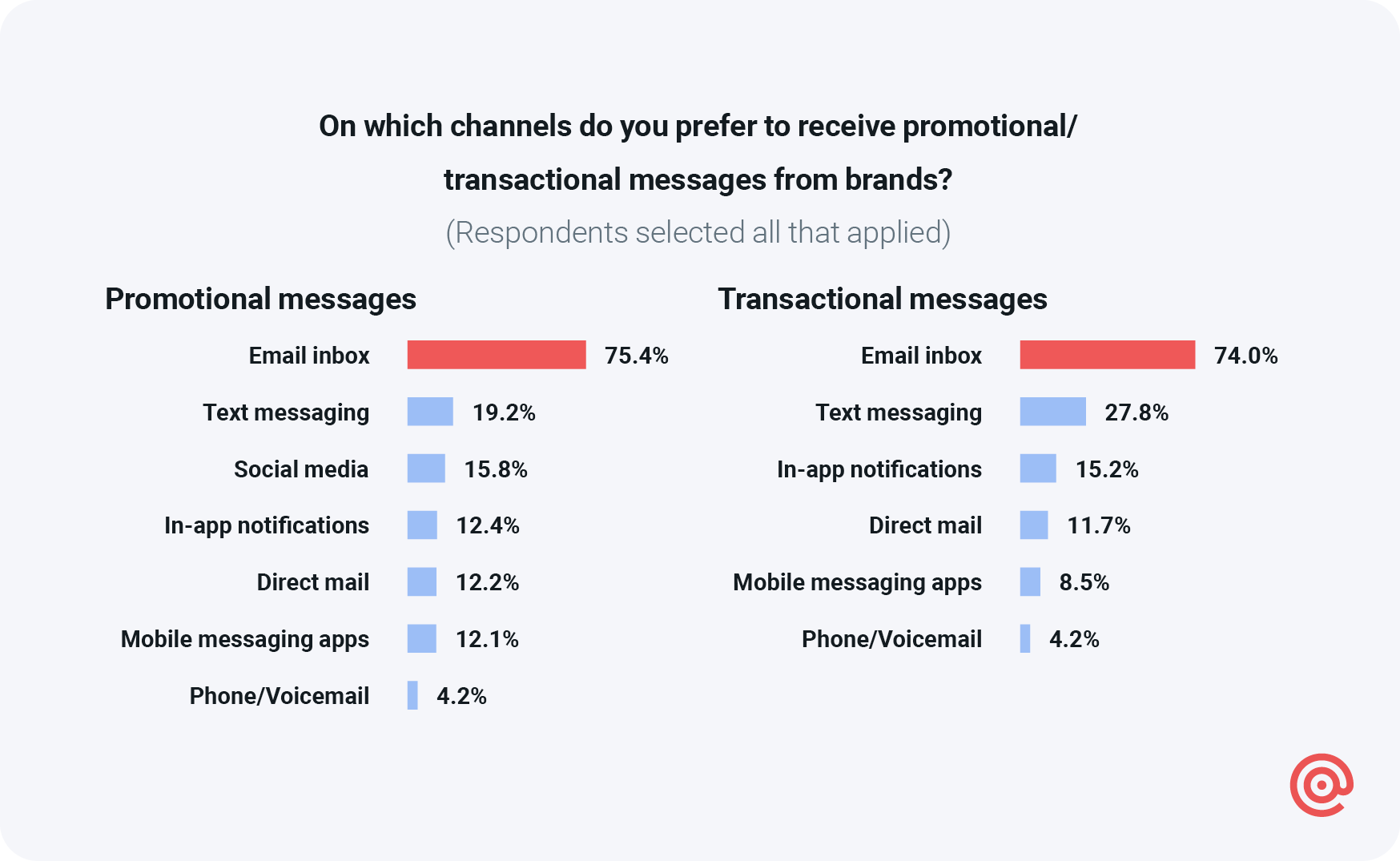
There’s no doubt that email should be a cornerstone of any company’s digital communication strategy. The inbox is a place where consumers are accustomed to hearing from brands. It’s where they already expect to find promotional campaigns and get informational notifications about orders, subscriptions, or access to their accounts.
However, email’s prevalence is not an excuse to ignore other customer communication channels.
Consumers may still view texting and mobile messaging applications as primarily peer-to-peer (P2P) communication channels. That, however, is likely to change as people become more accustomed to hearing from brands in a variety of ways. Innovative organizations are already improving the customer experience through multiple channels.
One example is SMS, which we referred to as text messaging in the consumer survey. You’ll notice that 27.8% of consumers selected SMS for transactional messages compared to 19.2% for promotional messages. SMS provides the immediacy and easy access consumers expect with transactional communications, making it an excellent way to support the customer experience.
At the same time, acceptance of promotions delivered via text and mobile messaging is growing as brands explore new ways to connect with consumers. That includes Rich Communication Services (RCS), which supports highly interactive experiences and delivers convenience through real-time, conversational messaging.
Our survey found 8.4% of consumers would choose to opt in for both email and SMS promotions while another 5.3% said either channel is acceptable for learning about a brand’s latest promotions. Furthermore, 64% of those surveyed are open to receiving promotional SMS messages from a brand at least once per month.
Around 75% of consumers prefer to hear from brands via email, but many people are open to receiving customer communications through a variety of other digital channels.
Where do consumers view emails?
Even though the digital landscape is always changing, building a solid customer experience for the inbox is imperative in 2024. That requires understanding how people use email in their everyday lives.
Inbox providers like Gmail, Outlook, and Yahoo offer different user experiences. They also have different rules connected to deliverability and their own scores for your sender reputation. Even the way an email gets rendered and displayed differs from one inbox to the next.
Our global survey found Gmail is by far the most-used mailbox provider. More than 72% of consumers reported having a personal Gmail account while more than one-third use Outlook and over 20% have a Yahoo Mail account.
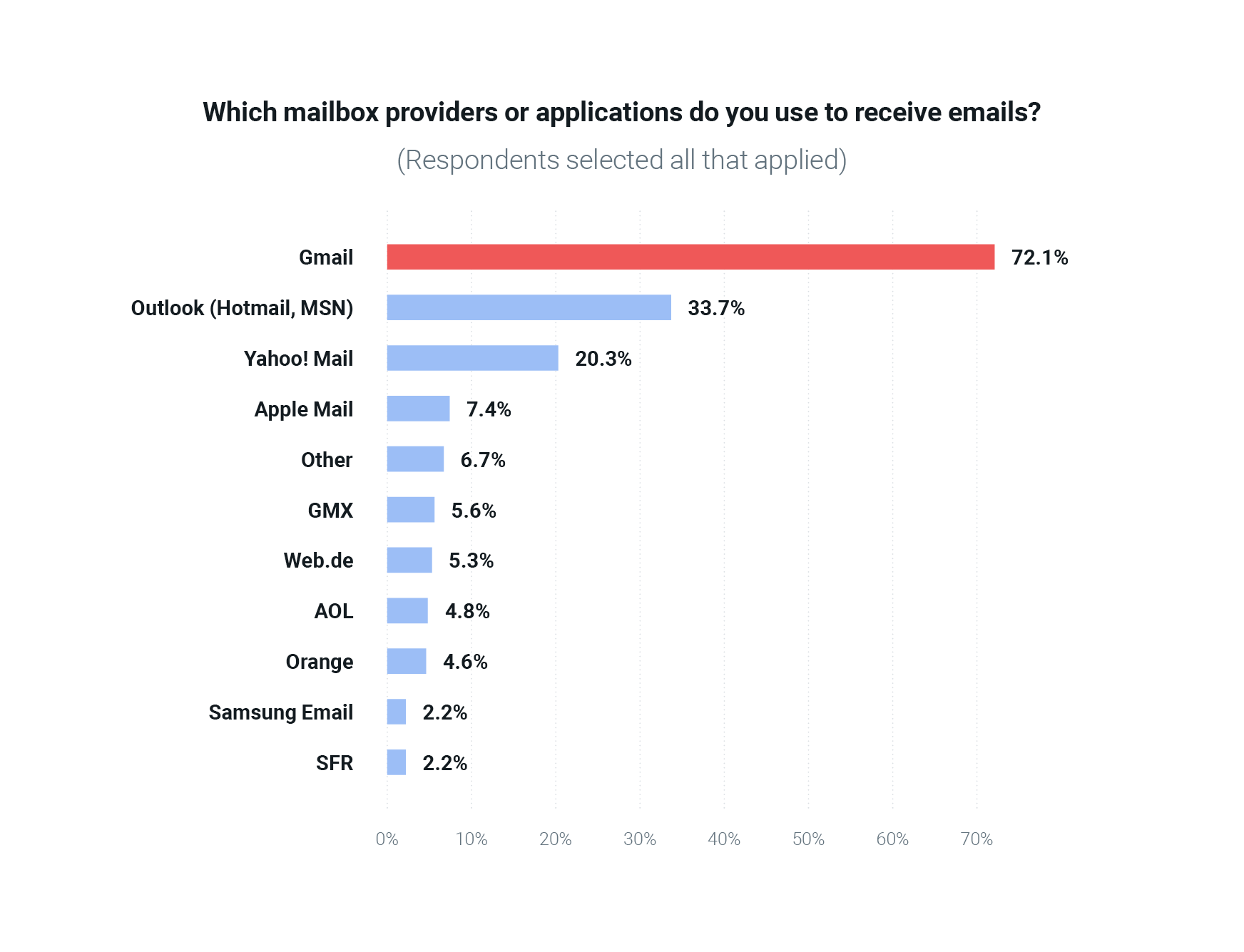
These findings highlight the importance of adhering to new bulk sender guidelines from Gmail and Yahoo. They include email authentication, thresholds for spam complaints, and an easy unsubscribe process. The 4.8% of people who use AOL for email are also part of the new requirements. Failure to follow the requirements will make it harder to reach consumers who are using these services.
Many of the other mailbox providers on the list represent services that are popular in specific regions around the world. That includes Apple Mail (7.4%), which is used often in the U.S. thanks to the iPhone’s popularity. European nations, which made up a large part of our survey, are less likely to use iPhones or Apple Mail. If your email analytics include information on the mailbox providers, clients, and devices used to view your messages, use it to better understand how to serve your customers.
The mobile email experience
Another unsurprising but crucial consideration for senders is the need to deliver mobile-friendly emails. Survey results reveal that 71.5% of consumers say they most often view emails on a smartphone or mobile device.
16.7% of respondents check email from a web browser on their computer while another 7.8% use a desktop application such as Outlook or Apple Mail. But that’s still less than 25% of consumers who say they regularly access their personal email from a desktop.
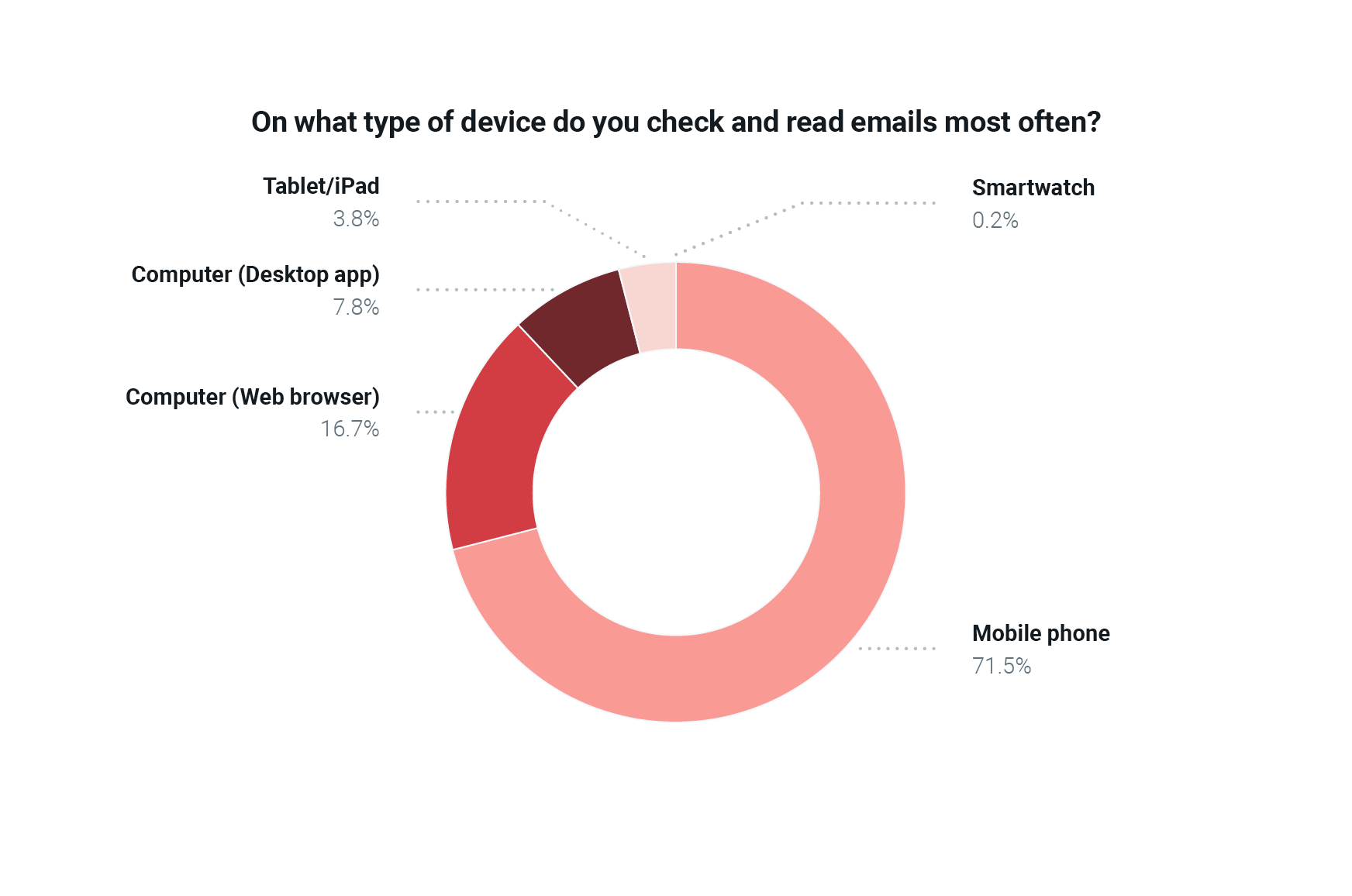
Some email marketing teams still struggle with designing responsive experiences for the email inbox so that campaigns adapt for various screen sizes. The people coding and creating your templates and promotional campaigns must take a mobile-first approach to email development. It’s an effective and efficient approach because what looks good on smaller screens usually works on desktops too.
71.5% of consumers primarily view emails on their phones. When you send an email that’s hard to read or engage with on a mobile device, you’re delivering a poor customer experience.
Download the full report to find out much more about consumers’ email checking habits, including how often they visit their inboxes and the times of day they’re most likely to check email.
Why do consumers open emails?
Sinch Mailgun’s Email and the customer experience report also explored the lifecycle of a B2C email subscriber. We wanted to find out what makes people sign up, open, and click.
Open rates remain one of the most important email metrics for monitoring performance, engagement, and even deliverability. You may assume subject lines are the key to achieving good email open rates, but survey results show your brand also plays a role.
When asked to rate the importance of factors connected to opening an email, consumers say the most important is having a familiarity with the brand sending the message. A combined 94.5% of respondents said Recognizing the sender name or brand name was Very important (65.2%) or Somewhat important (29.3%).
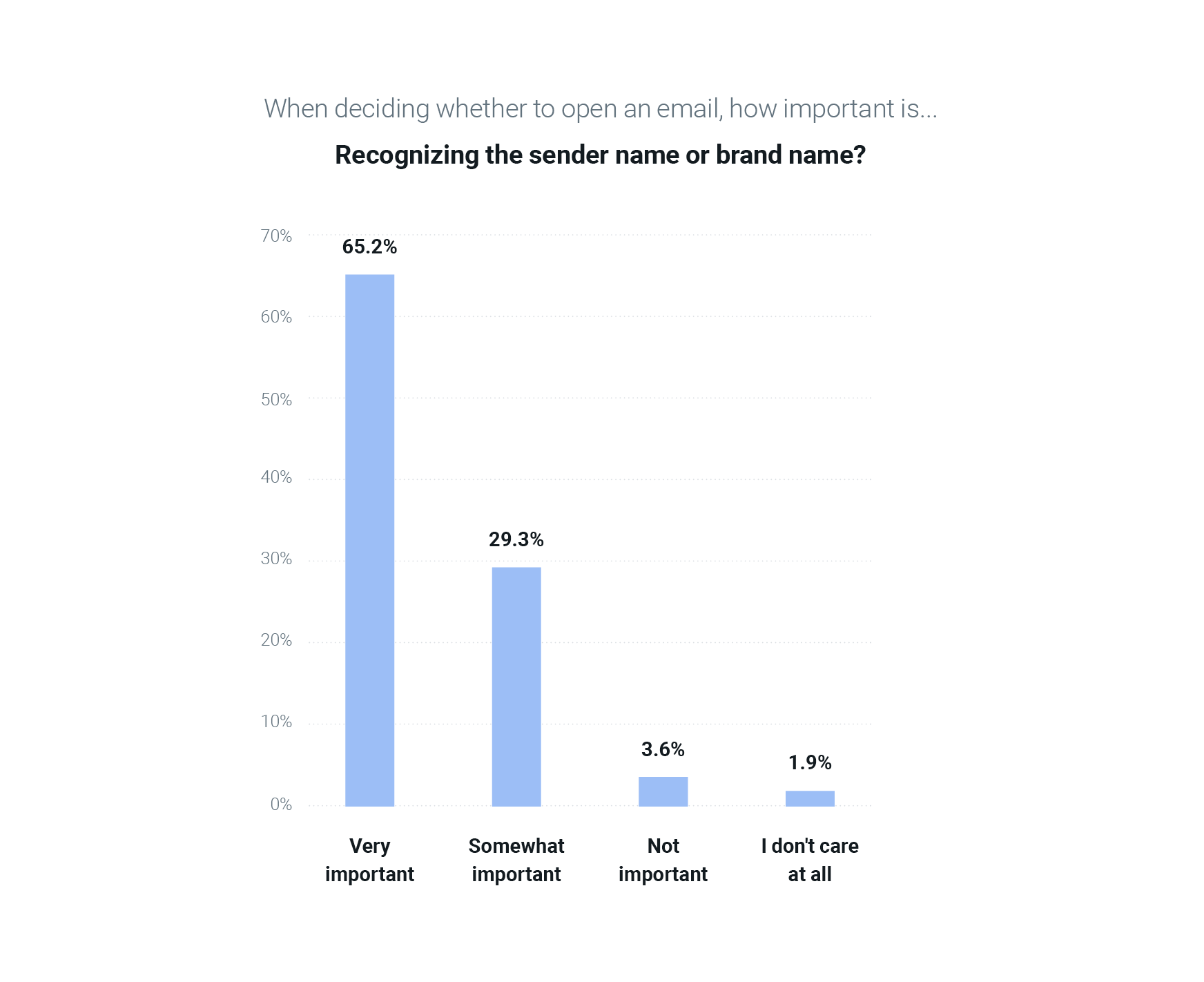
Recognizing the brand behind the email was seen as more important than all other factors in the survey. That includes personalized subject lines and the promise of a deal or discount.
This result explains why Gmail and Yahoo are requiring bulk senders to use strong email authentication in 2024. Authentication protocols such as SPF, DKIM, and DMARC, help mailbox providers verify the identity of the sender while keeping bad actors who try to imitate brands out of the inbox. Email spoofing is a common form of phishing and a growing problem thanks to the use of generative artificial intelligence (AI) for malicious purposes.
When a sender implements effective authentication methods, including an enforced DMARC policy, they’re eligible to have an official logo displayed at the inbox level. That’s thanks to a specification known as Brand Indicators for Message Identification (BIMI). Research from Verizon Media Group confirmed that the recognizability brands get from inbox logos can boost open rates and increase engagement by 10%.
The full report includes much more information from our consumer survey, including the top reasons for opting in and what convinces consumers to click through from an email to visit a brand’s website.
How can email ruin the customer experience?
While consumers may prefer the email inbox for customer communication, it can also be a source of stress and frustration. Not only does inbox clutter bother consumers, but it also makes it harder for brands to break through the noise and reach people via email.
When asked why they are most likely to unsubscribe from email communications, getting too many emails from a brand was the top reason at nearly 20%. Losing interest in the offerings and irrelevant email content were also top reasons for unsubscribing.
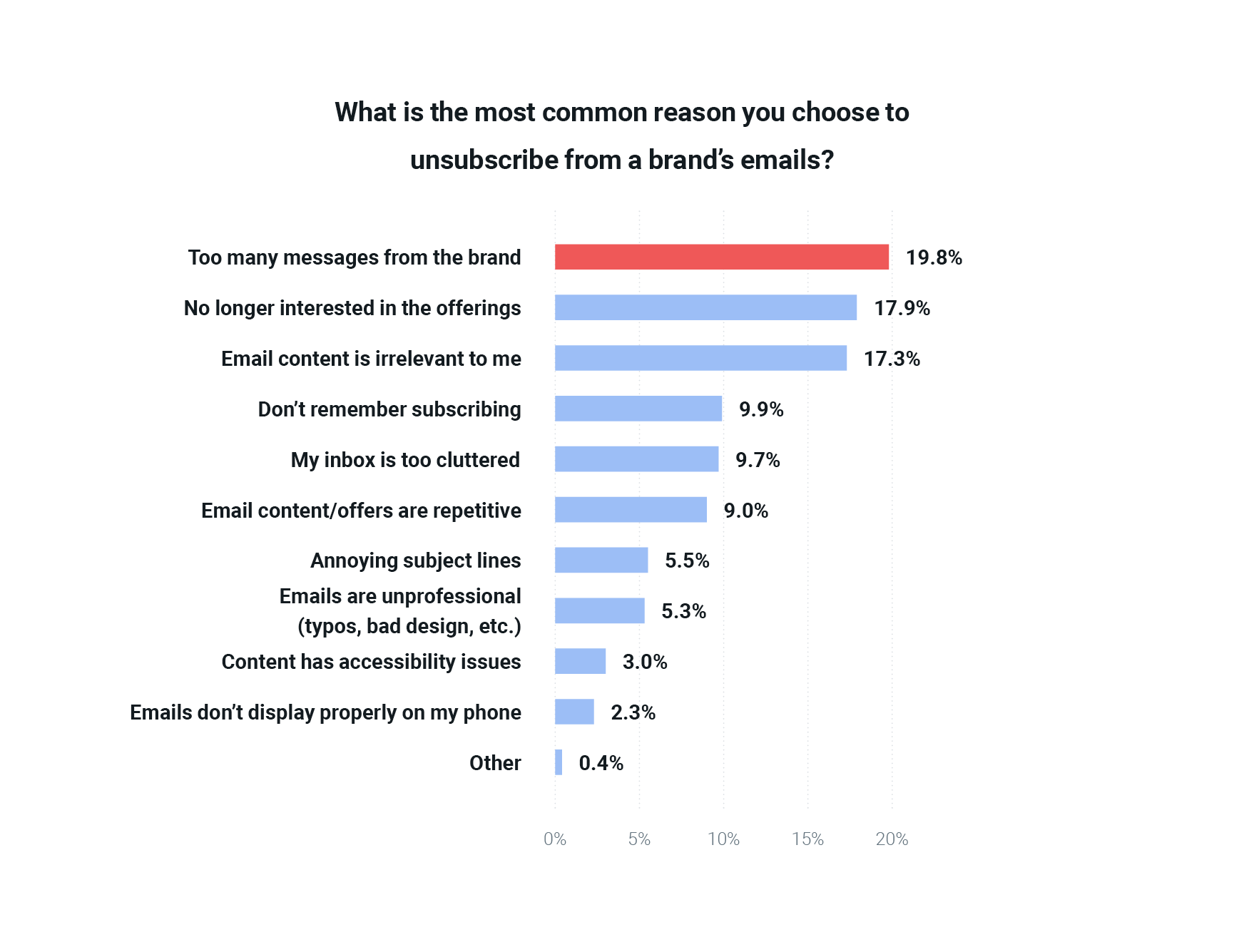
63% of consumers who took our survey reported receiving more than 10 emails from brands every day. However, 49.2% said they only open a few of those emails and 8% said they do not open any at all.
There’s no right answer for how frequently to send emails to your list. The right cadence will depend on your industry and what you offer. It’s also quite dependent on what the individual prefers. Our survey found around a quarter of consumers want to receive promotional emails weekly, but almost as many (22.8%) want to hear from brands every day. Close to another quarter of respondents chose either once or twice per month.
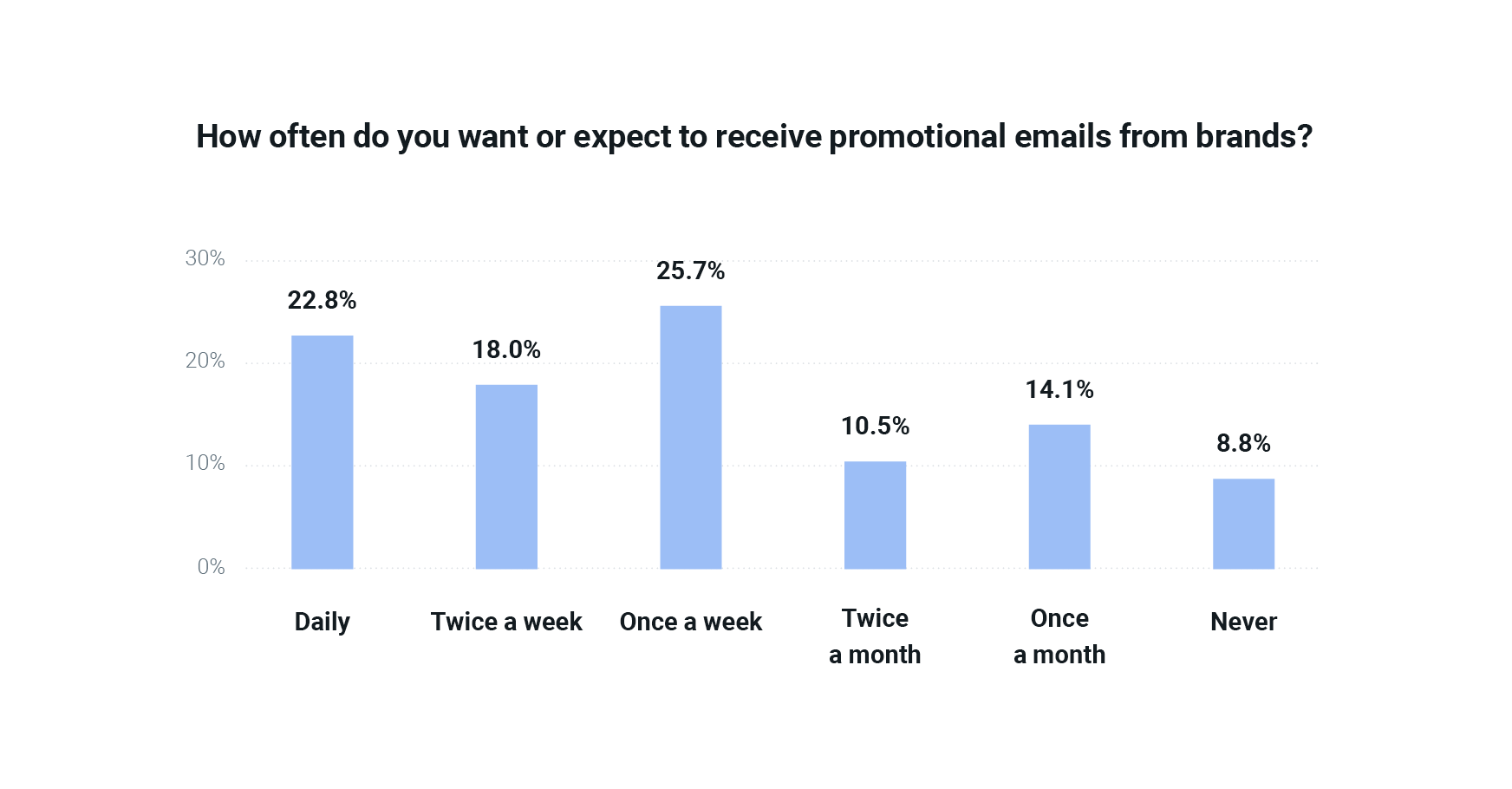
If you are still blasting your entire contact list with the same promotional campaigns at the same frequency, it’s time to make a change. An email preference center, for example, lets your contacts decide how often they want to hear from you and choose the content that will be most relevant to them. List segmentation helps you deliver more relevant email content to groups of consumers based on things like past purchases and demographics.
“Email is not dead, but the idea behind batch-and-blast mass email marketing is over. Now brands are sending highly targeted email traffic based on zero and first-party data. That’s how you keep consumers engaged and deliver a better customer experience.”
Kate Nowrouzi, VP, Deliverability and Product Strategy, Sinch Mailgun
When consumers are ready to unsubscribe for any reason, you should make it easy to do so. There’s no reason to keep sending to a contact that doesn’t want to hear from you anymore. In 2024, Gmail and Yahoo will enforce a one-click unsubscribe link located in the body of the email by using list-unsubscribe in the header.
On-demand webinar
Are you prepared for Google and Yahoo's new sender requirements?
View our fireside chat with Marcel Becker, Senior Director of Product at Yahoo, Anu Yamunan, Director of Product for Anti-Abuse & Safety at Google, and Kate Nowrouzi, Vice President of Deliverability at Sinch Mailgun, as we explore the new requirements for bulk email senders.
How deliverability supports the customer experience
There are certain types of emails that matter more to consumers than others. While promises of deals and discounts may motivate people to opt-in and encourage engagement, most transactional messages are already highly anticipated. Unlike marketing emails, transactional messages are one-to-one communications containing highly relevant and often personal or time sensitive information.
Transactional email is a foundational part of the overall customer experience. It needs to be reliable and timely, arriving almost immediately after placing an order or requesting a password reset, for example.
When transactional emails fail to show up, 71% of consumers say they would look for them in their spam folders. Another 16% of respondents would check spam for a missing transactional message if it was important.

This result shows how important transactional emails are to consumers. They can be even more important during certain times of the year, such as Black Friday and Cyber Monday shopping. But don’t assume a willingness to check spam is a reason to be unconcerned with your inbox placement rate.
When emails from a brand are regularly filtered into spam, it reflects poorly on your reputation. Nearly a third of consumers would be frustrated by this experience while 10% would lose trust in the brand and nearly the same number would unsubscribe.
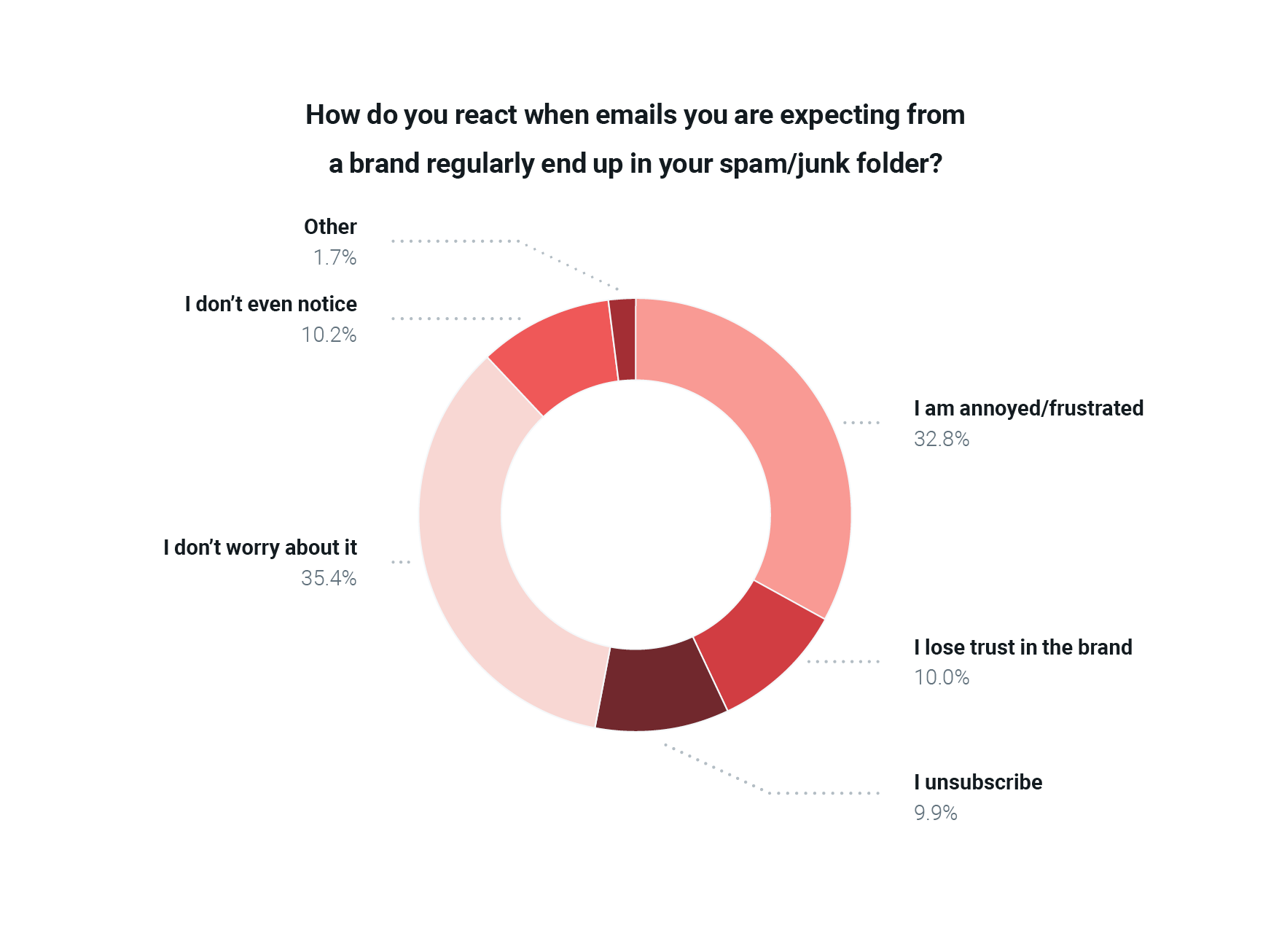
There are times when legitimate emails land in spam. There are also times when unsolicited emails make it to the inbox instead of spam. One way to combat this is through organic list building.
We truly hope you are complying with privacy laws such as GDPR and obtaining consent whenever necessary. Unfortunately, we know that some senders are still using unacceptable list building practices. Sinch Mailgun’s report, State of email deliverability 2025, revealed that 1 out of 10 senders admit they’ve purchased a list or scraped the web for contacts in the last two years. That number is even higher among high volume senders.
If you send to contacts who never opted in, you meet the definition of a spammer. Most consumers will have negative reactions to those unsolicited emails. Around 23% say they tend to ignore spam emails and more than 40% simply delete them. But 19.9%, or nearly 1 out of 5 consumers, would mark the email as spam.

When customers delete or ignore your company’s emails, it’s a sign of poor engagement that reflects poorly on your sender reputation. That could mean more of your company’s emails get filtered into junk.
The 19.9% of consumers who mark emails as spam will have an even bigger impact on your deliverability. Gmail and Yahoo are actively implementing specific thresholds for consumer-reported spam. If your spam complaint rate consistently exceeds 0.1%, you’ll no longer reach the inboxes of subscribers using Gmail and Yahoo. A spam complaint rate of 0.1% is one complaint for every 1,000 emails delivered. That’s why sending emails to a list of consumers who never subscribed is a huge mistake.
Does your email program support the customer experience?
The new requirements from Gmail and Yahoo are not designed to make things harder for senders. They are a push from mailbox providers to enlist the help of senders to make the inbox a better, safer place. Helping mailbox providers by authenticating, controlling spam, and adding easy unsubscribe links will let them help you land in the inbox.
The return on investment (ROI) from email continues to be much higher than other channels. However, if senders use email to spam consumers or deliver disappointing experiences to their customers, email will lose its power and effectiveness as a communication channel.
The choice is up to you. Will you act like a spammer and annoy people? Will you fail to focus on inbox placement and disappoint customers when they expect to hear from you? Or will your email program be something people can rely on, that adds value, and improves their everyday lives?
How to deliver what consumers want
Email and the customer experience 2024
The inbox is a cornerstone of customer communications, but it’s not easy to get people to open and click your emails. Find out what consumers have to say about how they prefer to hear from brands. Discover the results of a global survey and give them what they want. Download your copy now. No form filling required.







